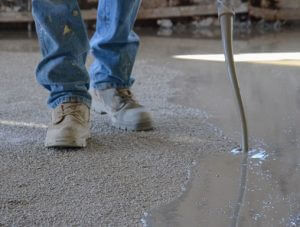Underlayments: When to Hand-Mix and When to Pump
Posted by Matt Milos on Jan 4th 2019
Should you pump or hand-mix self-leveling underlayments?
While pumping underlayment can be extremely useful, there are situations when the high output of pumping isn't the best solution. Alternatively, hand-mixing requires more man power and takes significantly more time. Depending on factors like volume, amount of open space, and size of workforce, either method could be more productive. So how do you determine when to pump and when to hand-mix?
Volume
At the most practical level: how many bags do you need? This is determined by both square footage and depth and is the first question you should ask. Below are our recommendations:
Less than 300 bags: Hand-mix.
On smaller jobs pumps can be overkill. Would you hire a tree trimming service for a couple shoulder-height hedges around your home? Setting up, tearing down, and then cleaning pump equipment is for many contractors too much hassle for a job that requires less than three hundred bags.
More than 300 bags: Pump.
Pumps are ideal for high-volume jobs where fast, heavy output is the most effective way to get the job done. An efficient pump job can free up time and workers to complete other tasks. Many primers have minimum dry times and an "open" time to apply the underlayment. Instead of keeping your crew on hold for hours waiting for primer, you can take advantage of the pump's high output to more strategically and efficiently complete the job.
Space
Is the work area open or segmented? Do you have enough space to move a pump? Even on a high-volume job hand mixing may be the best choice if your work area is split up by walls or other barriers. If a large project has many rooms, moving a pump around the structure quickly becomes difficult and time consuming. In contrast, renovation or repurposing projects that are open and will eventually involve the installation of new walls are perfect for pumping. In these situations the contractor can work on the whole surface while it remains open.

Space, output, work-force...choosing to hand-mix or pump involves many factors.
Workforce
Do you have enough people on the job to properly man a pump? An understaffed pump will quickly outrun its operators. Pumps can use anywhere from 180 to 270 bags every hour. That's a minimum of three bags every minute—one bag every twenty seconds. This kind of high-volume work requires people devoted exclusively to feeding the pump and to properly spreading out the material. If you have a smaller workforce, we recommend using a hand mixer like the BNR6400 for churning out work quickly even with few hands.
On the other hand, larger jobs require a small army if hand-mixing is your method. A long day with a large team is expensive. Let's compare labor costs for pumps and hand-mixing:
Example: 15,000 sqft at 1/4" of underlayment
Hand-Mixing 500 Bags
9 people: 3 at mix stations, 2 to transport material, 1 to rake, 1 to smooth, and 1 extra for backup.
At an average rate of 60 bags an hour this will take roughly 9 hours with minimal clean up.
With a rate of $70/hr per laborer* this job will cost $5,670 in labor alone.
Pumping 500 Bags
7 people: 2 to feed the mixer, 1 to stage the material, 1 to smooth, 2 on the pump hose, and 1 extra for backup.
4 hours of work total: 1 hour for setup and cleanup each and 2 hours for the pumping itself.
At the same hourly rate, this job will cost $1,960 in labor.
In this example the $3,710 difference in labor makes pumping the more efficient option. Though this offers a basic guideline for needed labor hours, each project has its own unique variables and challenges.

Using a pump can help you use your workforce more efficiently.
Mix Times
Many underlayments have minimum mix times required for them to work as engineered. Pumps carry the risk of sending out the material before it has been properly mixed, leading to uneven, damaged surfaces. Always check if your material is compatible with the pump you intend to use. If your pump cannot go slow enough for the material, your best bet is to switch to hand-mixing.
That said, Phipps carries both the Graco ToughTek CM40 Mixer and ToughTek P30 Pump, which when used in combination allow contractors to slow down mixing time. This system is a common solution for the contractor who wants to pump without compromising the material. When your project conditions call for large-scale production, using a pump can improve both productivity and profitability.
Applying underlayment is a simple task that can go wrong in a lot of places, and how to mix it is just one of them. Asking yourself the right questions in advance is the best way to know which method to use.
Phipps carries a full line of underlayments from Ardex and BASF as well as multiple pump options from Quikspray and Graco. Call or visit today to find the best choice for your project.
*Calculated from average union labor


